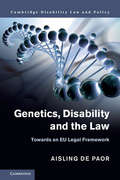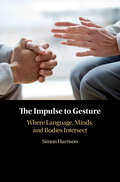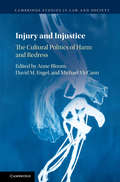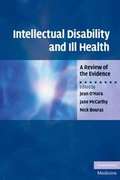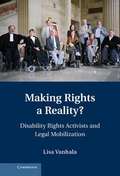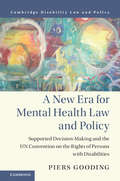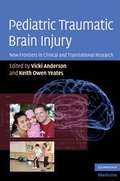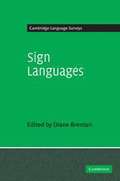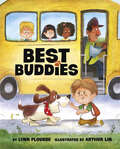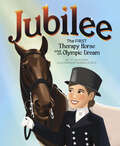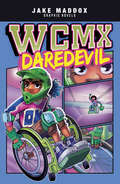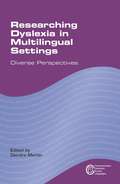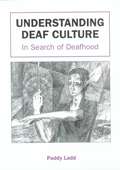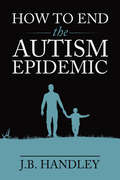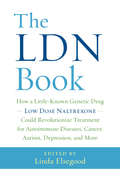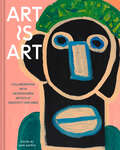- Table View
- List View
Genetics, Disability and the Law: Towards an EU Legal Framework (Cambridge Disability Law and Policy Series)
by Aisling De PaorWhile advances in science and technology bring many advantages, we must not ignore the harm that they can cause. Rapid changes in genetic testing are a prime example, and indicators can now help to detect, address and treat diseases. However, in this new study, Aisling de Paor examines how genetic testing is also being used for non-medical reasons, for example for work opportunities and insurance coverage. Genetics, Disability and the Law is the first book of its kind to substantively consider an EU-level response to the use of genetic information. de Paor discusses how to help genetic and scientific research to evolve and grow, how to enhance public confidence in research, and how to control it so that it recognises our values and fundamental human rights. An understudied but vitally important topic, de Paor's work provides a valuable and timely contribution to the field of disability rights. Presents a practical consideration of an EU-level legislative response to controlling the use and misuse of genetic information, appealing to those involved in the regulation of this field Takes a human rights and disability approach to considering the regulation of genetic information, which will interest scholars and policymakers from a variety of disciplines, in particular because it considers the intersection of disability and genetics Considers normative and non-normative attitudes to the regulation of genetic information, giving readers a new and varied insight
Health Inequalities and People with Intellectual Disabilities
by Eric Emerson Chris HattonPeople with intellectual disabilities die at a younger age and have poorer health than their non-disabled peers. This is largely avoidable and is unjust. This book uses concepts from contemporary public health to provide a comprehensive evidence-based overview of: the nature and extent of the health inequalities experienced by people with intellectual disabilities; why these inequalities occur and persist; and what can and needs to be done to address these inequalities. The authors have a wealth of firsthand experience gained from years of working at the interface between disability research and public health. This experience is collected and shared in this volume, which will be an invaluable resource for practitioners, advocates, policymakers and researchers concerned with health and social care and the wellbeing of disabled people.
The Impulse to Gesture: Where Language, Minds, and Bodies Intersect
by Simon HarrisonGestures are central to the way people use language when they interact. This book places our impulse to gesture at the very heart of linguistic structure: grammar. Based on the phenomenon of negation - a linguistic universal with clear grammatical and gestural manifestations - Simon Harrison argues that linguistic concepts are fundamentally multi modal and shows how they lead to recurrent bindings between grammar and gesture when people speak. Studying how speakers express negation multi modally in a range of social and professional contexts, Harrison explores how and when people gesture, what people achieve linguistically and discursively with their gestures, and why we find similar uses of gesture in different languages (including spoken and signed language). Establishing the inseparability of grammar and gesture, this book is an important reference for any researcher interested in the relation between language, gesture, and cognition.
Injury and Injustice: The Cultural Politics of Harm and Redress (Cambridge Studies in Law and Society)
by David M. Engel Anne Bloom Michael McCannThis book addresses some of the most difficult and important debates over injury and law now taking place in societies around the world. The essays tackle the inescapable experience of injury and its implications for social inequality in different cultural settings. Topics include the tension between physical and reputational injuries, the construction of human injuries versus injuries to non-human life, virtual injuries, the normalization and infliction of injuries on vulnerable victims, the question of reparations for slavery, and the paradoxical degradation of victims through legal actions meant to compensate them for their disabilities. Authors include social theorists, social scientists and legal scholars, and the subject matter extends to the Middle East and Asia, as well as North America.
Intellectual Disability and Ill Health
by Jean O'Hara Jane Mccarthy Nick BourasPeople with intellectual disability often have health needs that go unrecognised and untreated; this may be because of difficulties in communication, diagnostic overshadowing, discrimination or indifference. There is concern that public health measures aimed at reducing the main health killers in the population will not address these issues for people with intellectual disability and may preferentially widen the inequality that already exists. This book is a comprehensive and systematic review of physical and mental health co-morbidities in people with intellectual disability. Such an evidence base is vital in shaping public health policy, healthcare commissioning and the development of more effective healthcare systems, as well as supporting better understanding and practice at an individual clinical level. This is essential reading for policy makers and commissioners of services, as well as individual practitioners across mainstream and specialist health and social care, in considering not only service developments but practice at the coalface.
Land Use Law and Disability
by Robin Paul MalloyIn Land Use Law and Disability, Robin Paul Malloy argues that our communities need better planning to be safely and easily navigated by people with mobility impairment and to facilitate intergenerational aging in place. To achieve this, communities will need to think of mobility impairment and inclusive design as land use and planning issues, in addition to understanding them as matters of civil and constitutional rights. Although much has been written about the rights of people with disabilities, little has been said about the interplay between disability and land use regulation. This book undertakes to explain mobility impairment, as one type of disability, in terms of planning and zoning. The goal is to advance our understanding of disability in terms of planning and zoning to facilitate cooperative engagement between disability rights advocates and land use professionals. This in turn should lead to improved community planning for accessibility and aging in place.
The Linguistics of British Sign Language
by Rachel Sutton-Spence Bencie Woll<P>This is the first detailed explanation of the way British Sign Language works and is the product of many years' experience of research and teaching sign linguistics to deaf and hearing people. It assumes no previous knowledge of linguistics or sign language, and is not structured around traditional headings such as phonology, morphology and syntax. Instead it is set out in such a way as to help learners and their teachers understand the linguistic principles behind the language. There are sections on BSL grammar and also on the use of BSL, including social acceptability in signing, variation, and poetry and humour in BSL. <P>Technical terms and linguistic jargon are kept to a minimum, and the text contains many examples from English, BSL, and other spoken and sign languages. The book is amply illustrated and contains exercises, as well as a reading list for further study.
Making Rights a Reality? Disability Rights Activists and Legal Mobilization
by Lisa VanhalaMaking Rights a Reality? explores the way in which disability activists in the United Kingdom and Canada have transformed their aspirations into legal claims in their quest for equality. It unpacks shifting conceptualizations of the political identity of disability and the role of a rights discourse in these dynamics. In doing so, it delves into the diffusion of disability rights among grassroots organizations and the traditional disability charities. The book draws on a wealth of primary sources including court records and campaign documents and encompassing interviews with more than sixty activists and legal experts. While showing that the disability rights movement has had a significant impact on equality jurisprudence in two countries, the book also demonstrates that the act of mobilizing rights can have consequences, both intended and unintended, for social movements themselves.
Neurocognitive Rehabilitation of Down Syndrome
by Donna Spiker Jean-Adolphe Rondal Juan PereraDown syndrome is one of the most commonly occurring developmental disorders and it is now possible to conceptualize and define opportunities for neurocognitive rehabilitation for those with the condition. This book describes how early cognitive intervention in children with Down syndrome can be carried out, and can reduce, or compensate for, the major deficits characteristic of the condition. This comprehensive account relates the neurocognitive approach to the major therapeutic endeavors in the neighboring fields of neurogenetics, experimental environmental enrichment, molecular genetics, pharmacology, pediatrics and cardiology for infants with Down syndrome. Neurocognitive Rehabilitation of Down Syndrome provides the guidance required to establish effective rehabilitation programs, and is essential reading for developmental clinicians, pediatricians, neuropsychologists and other health professionals.
A New Era for Mental Health Law and Policy: Supported Decision-Making and the UN Convention on the Rights of Persons with Disabilities (Cambridge Disability Law and Policy Series)
by Piers GoodingThe Convention on the Rights of Persons with Disabilities (CRPD) has generated new ideas and standards in healthcare and disability law and policy. In the mental health context, the CRPD directs governments to ensure people with mental impairments are treated equally before the law, including ensuring people have access to the resources necessary to enjoy their rights. But what this means in practice remains unclear. In addition, current domestic laws that authorise involuntary psychiatric interventions stand at cross-purposes with the CRPD, which requires respect for the 'will, preference and rights' of persons with disabilities 'on an equal basis with others'. This book explores the implications of the CRPD for law, policy and practice that responds to the complex issues raised by mental health impairment and disability. It argues that the support framework of the CRPD holds potential to address persistent shortcomings in mental health law and policy. Proposes a new approach to mental health and the law Promotes the application of international human rights law to mental health law, policy and practice Considers new solutions to longstanding problems regarding coercive mental health treatment
Pediatric Traumatic Brain Injury
by Vicki Anderson Keith Owen YeatesTraumatic brain injury (TBI) is a leading cause of death and disability in children and adolescents Worldwide and represents a largely "silent" public health epidemic. Advances in acute medical care have resulted in better survival rates, but long-term quality of life remains of ongoing concern. The cognitive, emotional and behavioral consequences of TBI frequently pose life long problems for these children and their families leading to substantial economic and societal costs.
Psychiatric and Behavioral Disorders in Intellectual and Developmental Disabilities
by Hemmings, Colin and Bouras, Nick Colin Hemmings Nick BourasFully revised, this new edition reviews the most up-to-date and clinically relevant information on the mental health and behavioral problems of people with intellectual, developmental and learning disabilities, also previously known as mental retardation. Providing the latest evidence base from the literature and embracing clinical experience, it covers the essential facts and concepts relating to coexisting medical and psychiatric disorders, with new and updated chapters on mental health and epilepsy, schizophrenia spectrum disorders, personality disorders, and mental health problems in people with autism and related disorders. The disorder-based chapters are complemented by chapters on carer and family perspectives, possible future developments and contributions highlighting the principles of assessment, management and services from global and historical perspectives. This is essential hands-on practical advice for psychiatrists, psychologists and all other mental health professionals including nurses, therapists, social workers, managers, service providers and commissioners.
Reproductive Endocrinology for the MRCOG and Beyond
by Adam Balen Jenny HighamUnderstanding endocrinology is central to understanding the key processes that affect normal reproductive function, while an understanding of normal endocrinology and the pathophysiology of endocrine disorders is important when dealing with reproductive disorders. This book provides a comprehensive background for all gynaecologists, covering: sexual differentiation and intersex disorders; adrenal disorders; normal puberty and adolescence; abnormal puberty; the menstrual cycle; disorders of menstruation; amenorrhoea; polycystic ovary syndrome; anovulatory fertility and ovulation induction; lactation and lactational amenorrhoea; hyperprolactinaemia; thyroid disease; diabetes; lipid metabolism and lipoprotein transport; premature ovarian failure; and calcium metabolism and its disorders. The book is primarily designed to provide a comprehensive summary for candidates preparing for the Part 2 MRCOG examination, and as such covers the RCOG curriculum for reproductive endocrinology. It is also a valuable guide for all healthcare professionals working in the field, including trainees, consultants and any health professional coming into contact with women.
Sign Languages
by Diane BrentariThis series offers general accounts of the major language families of the world, with volumes organized either on a purely genetic basis or on a geographical basis, whichever yields the most convenient and intelligible grouping in each case. Each volume compares and contrasts the typological features of the languages it deals with. It also treats the relevant genetic relationships, historical development, and sociolinguistic issues arising from their role and use in the world today. The books are intended for linguists from undergraduate level upwards, but no special knowledge of the languages under consideration is assumed. Volumes such as those on Australia and the Amazon Basin are also of wider relevance, as the future of the languages and their speakers raises important social and political issues.
Social Class and Educational Inequality: The Impact of Parents and Schools
by Iram Siraj Aziza MayoSocial class is often seen as an intractable barrier to success, yet a number of children from disadvantaged backgrounds still manage to show resilience and succeed against the odds. This book presents the findings from fifty Child and Family Case Studies (CFCS) conducted with 13–16 year olds. The authors look specifically at the roles that people and experiences - at home, in schools and in the wider community - have played in the learning life-courses of these children; how these factors have affected their achievement; and explanations and meanings given by respondents to the unique characteristics, experiences and events in their lives. Featuring the voices of real parents and children, and backed up by a decade of quantitative data, this is a compelling record that will help readers to understand the complex nature of social disadvantage and the interplay between risk and protective factors in homes and schools that can make for a transformational educational experience.
Sociolinguistics and Deaf Communities
by Adam C. Schembri Ceil LucasHow do people use sign languages in different situations around the world? How are sign languages distributed globally? What happens when they come in contact with spoken and written languages? These and other questions are explored in this new introduction to the sociolinguistics of sign languages and deaf communities. An international team brings insights and data from a wide range of sign languages, from the USA, Canada, England, Spain, Brazil and Australia. Topics covered include multilingualism in the global deaf community, sociolinguistic variation and change in sign languages, bilingualism and language contact between signed and spoken languages, attitudes towards sign languages, sign language planning and policy, and sign language discourse. Sociolinguistics and Deaf Communities will be welcomed by students of sign language and interpreting, teachers of sign language, and students and academics working in linguistics.
Best Buddies
by Lynn PlourdeBest Buddies introduces a boy-and-dog duo who are BEST FRIENDS and who do EVERYTHING together! So how will they manage being apart when the boy heads to school for the first time? Find out how a clever boy with Down syndrome and his loyal pet find the perfect way to feel close even when they can’t be together. A sweet, inspiring story that will ease concerns about the first day of school and other big changes for kids.
Jubilee: The First Therapy Horse and an Olympic Dream
by KT JohnstonLis Hartel became paralyzed after contracting polio in 1944. Her dreams of riding horses and competing in the sport of dressage were shattered. After months in the hospital, doctors told her she’d never ride again. Lis tried anyway. How do you stay on a horse without using your legs? How do you give the subtle cues needed in dressage with limited mobility? With hard work—and an unlikely horse named Jubilee. After years of training together and creating a new way of communicating, Lis and Jubilee danced into the competition ring, and eventually all the way to the Olympics. Lis Hartel was the first woman with a disability ever to win an Olympic medal, and the first woman to stand equally beside men on the Olympic winners' podium in any sport.
WCMX Daredevil (Jake Maddox Graphic Novels)
by Jake MaddoxDavalyn “The Daredevil” Hart may be a new rider in the sport of wheelchair motocross, but this adrenaline junkie is ready to push herself. When she gets a new WCMX chair designed to take a beating at the skate park, she turns her stunts up to the next level. But everything comes to a grinding halt when she attempts a tough trick and takes a hard fall. Now her confidence is rattled. Can she find the courage to face the rails again and nail her special move at the upcoming WCMX Extreme Games competition?
Researching Dyslexia in Multilingual Settings
by Deirdre MartinThis volume draws together current research on dyslexia and literacy in multilingual settings across disciplines and methodologies. The contributors, all internationally recognised in the field, address developmental and acquired literacy difficulties and dyslexia in a range of language contexts including EAL/EFL. The book uses theories and analytical frameworks of a critical nature to reveal prejudicial social practices, and suggests future research directions towards a critical re-consideration of current understandings of dyslexia in multilingual settings, with a view to foregrounding the potential for interdisciplinarity. The book also suggests ways forward for evidence-informed practice, and it will be a valuable resource for researchers, practitioners and students alike.
Understanding Deaf Culture
by Paddy LaddThis book presents a 'Traveller's Guide' to Deaf Culture, starting from the premise that Deaf cultures have an important contribution to make to other academic disciplines, and human lives in general. Within and outside Deaf communities, there is a need for an account of the new concept of Deaf culture, which enables readers to assess its place alongside work on other minority cultures and multilingual discourses. The book aims to assess the concepts of culture, on their own terms and in their many guises and to apply these to Deaf communities. The author illustrates the pitfalls which have been created for those communities by the medical concept of 'deafness' and contrasts this with his new concept of "Deafhood", a process by which every Deaf child, family and adult implicitly explains their existence in the world to themselves and each other.
How to End the Autism Epidemic: Revealing The Truth About Vaccines
by J. B. HandleyIn How to End the Autism Epidemic, Generation Rescue’s co-founder J.B. Handley offers a compelling, science-based explanation of what’s causing the autism epidemic, the lies that enable its perpetuation, and the steps we must take as parents and as a society in order to end it. While many parents have heard the rhetoric that vaccines are safe and effective and that the science is settled about the relationship between vaccines and autism, few realize that in the 1960s, American children received three vaccines compared to the thirty-eight they receive today. Or that when parents are told that the odds of an adverse reaction are “one in a million,” the odds are actually one in fifty. Or that in the 1980s, the rate of autism was one in ten thousand children. Today it’s one in thirty-six. Parents, educators, and social service professionals around the country are sounding an alarm that we are in the midst of a devastating public health crisis—one that corresponds in lockstep with an ever-growing vaccine schedule. Why do our public health officials refuse to investigate this properly—or even acknowledge it? In How to End the Autism Epidemic, Handley confronts and dismantles the most common lies about vaccines and autism. He then lays out, in detail, what the truth actually is: new published science links the aluminium adjuvant used in vaccines to immune activation events in the brains of infants, triggering autism; and there is a clear legal basis for the statement that vaccines cause autism, including previously undisclosed depositions of prominent autism scientists under oath. While Handley’s argument is unsparing, his position is ultimately moderate and constructive: we must continue to investigate the safety of vaccines, we must adopt a position of informed consent, and every individual vaccine must be considered on its own merits. This issue is far from settled. By refusing to engage with parents and other stakeholders in a meaningful way, our public health officials destroy the public trust and enable the suffering of countless children and families.
The LDN Book: How a Little-Known Generic Drug - Low Dose Naltrexone - Could Revolutionize Treatment for Autoimmune Diseases, Cancer, Autism, Depression, and More
by Linda ElsegoodLow Dose Naltrexone (LDN) holds the potential to help millions of people suffering from various autoimmune diseases and cancers, and even autism, chronic fatigue, and depression, find relief. Administered off-label in small daily doses (0.5 to 4.5 mg), this generic drug is extremely affordable and presents few known side effects. So why has it languished in relative medical obscurity? The LDN Book explains the drug's origins, its primary mechanism, and the latest research from practicing physicians and pharmacists as compiled by Linda Elsegood of The LDN Research Trust, the world's largest LDN charity organization with over 19,000 members worldwide. Featuring ten chapters contributed by medical professionals on LDN's efficacy and two patient-friendly appendices, The LDN Book is a comprehensive resource for doctors, pharmacists, and patients who want to learn more about how LDN is helping people now, and a clarion call for further research that could help millions more.
Any Bitter Thing
by Monica WoodLizzy is 30 years old when she almost dies from getting hit by a car. As she recovers, she revisits her childhood being brought up by a priest falsely accused of molestation.
Art Is Art: 40 Years of Collaborating with Neurodiverse Artists at Creativity Explored
by Ann KappesCreativity Explored celebrates its 40th anniversary with a collection of powerful artwork and perspectives from its talented studio artists.This vibrant book uplifts the voices of the artists of Creativity Explored, a nonprofit that gives people with developmental disabilities the opportunity to express themselves through art and share their work with audiences from their local community and in the contemporary art world.This curated collection features more than one hundred original paintings, drawings, illustrations, and sculptures—as well as quotes and stories from the artists—inviting readers to examine and challenge their perceptions about disability. Some artworks are humorous and blunt, while others are affecting and abstract, speaking to the artistic community's diversity and creativity. This book offers an engaging introduction to person-centered thinking for art lovers or anyone interested in learning about disability justice in a visual way.DEMYSTIFYING DISABILITY: This significant new anthology showcases an array of developmentally disabled artists and organizes their works into thematic chapters, such as "Self Medication," "On the Spectrum," "Yes I Do Think About Sex," and "Our Fears." These chapters provide interesting stylistic juxtapositions and personal reflections that highlight both individual and shared experiences as diverse disabled artists. BEAUTIFUL AND CONTENT RICH: This gorgeous hardcover art book features more than one hundred original artworks in full color, from lively portraits and detailed drawings to abstract paintings and captivating illustrations. Quotes, interviews, personal stories, and artist statements also give readers deeper insight into the artists' creative practices, processes, and rituals. This book is a rich visual trove and source of inspiration for any contemporary art lover. SUPPORT A GREAT CAUSE: Creativity Explored was founded in 1983 with the belief that art is essential to life. This book celebrates the organization's mission and its talented artists after forty years of creating impactful arts and career programs with developmentally disabled artists. This collection is a meaningful way to learn more about Creativity Explored and the diverse community it continues to support today.Perfect for:Art lovers and activistsPeople who admire the mission and work of Creativity ExploredThe disabled community, allies, and educatorsGift seekers for family and friends interested in learning more about disability justiceFans of self-taught artists, folk arts, and "outsider art"Contemporary art anthology and art book collectors#OwnVoices readers and anyone interested in diversifying their contemporary art knowledge
